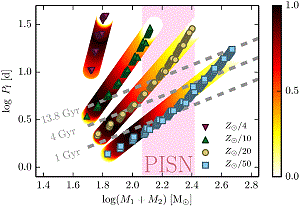- Details
- Published on 12 February 2016
Vol. 588
In section 7. Stellar structure and evolution
A new route towards merging massive black holes

Studies that attempt to characterize the systems and signals from gravitational wave sources have received new impetus from the improved sensitivity of the current generation of gravitational wave detectors. In this study, Marchant et al. systematically explore a new channel that results in tight black hole binary that is likely to merge well within a Hubble time via the emission of gravitational wave radiation. The formation of tight binary systems resulting from massive stars generally requires at least one common-envelope phase, which is notoriously difficult to model realistically. This study very neatly avoids this problem because they consider binary systems where the massive stars are tidally locked. This forces the stars to evolve homogeneously, which completely bypasses the red supergiant phase, thereby avoiding an increase in the semi-major axis of the system. These massive overcontact binaries ultimately result in tight black hole binaries, but only if the metallicity is low enough that angular momentum loss via, e.g., stellar winds is unimportant, and the short orbital period can be maintained. The study goes on to map the parameter space of black hole - black hole mergers, providing the expected chirp mass distribution and merger times. In a truly remarkable and historically important turn of events, the Advanced LIGO team reported the direct detection of gravitational waves from a likely 36+29 solar mass black hole binary system, in the same week as the above study was accepted for publication in A&A!


